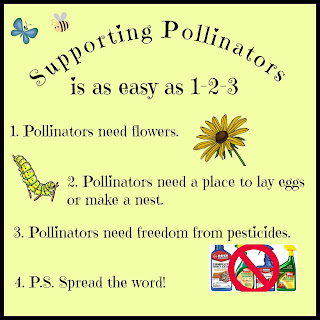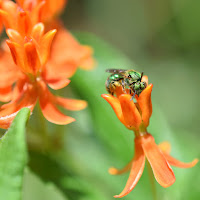This is the end of Pollinator Week 2019 but of course it is
never really the end of our support for them. I’m grateful to have this week
designated to ensure that we all take the time to think about making choices
that help them not just survive but thrive. Few things in nature make me as
happy as seeing a native insect interacting with a native plant (such as this metallic green sweat bee on orange milkweed, Asclepias tuberosa, found in my yard this week).
This week’s messaging by The Xerces Society, a fabulous organization, included reminders about their Bring Back the Pollinators campaign. This campaign has such a simple message that I decided to highlight it here. The campaign has four principles:
- Provide pollinators with flowers from which to drink nectar and gather pollen.
- Provide them with places to lay their eggs or build a nest.
- Provide an environment that is free from pesticides.
- Spread the word about helping pollinators.
 |
| Here's a shareable graphic! |
There are decisions to be made in each one of those principles. For example, in principle 1, flowers need to be available in spring, summer, and fall so plant selections should be varied. I covered plant selection in the second of my recent posts on planting for pollinators. You can also find plant lists in that post.
 |
| Southward bound monarchs need fall flowers |
Plant selection is also a critical factor in principle 2 for the pollinators that need to lay their eggs on specific plants – these are known as ‘insect herbivores’ and are primarily the butterflies and moths. Think about the monarch butterfly laying her eggs on milkweed. For bees, principle 2 is addressed in some of the maintenance points (e.g., leaving stems and bare ground) that I outline in the third of my posts on pollinators.
 |
| A buckeye caterpillar turns into ... |
 |
| A buckeye butterfly! |
Not using pesticides should be well understood if you actually want to have insects, but sometimes companies try to convince us that their product is ‘safe.’ However, studies are finding that products meant to control one type of insect actually do harm non-target species, and that even ‘natural’ products cause some harm. The rise in usage of mosquito misting companies is particularly alarming, and harm to pollinators in the area is increasingly documented.
Who doesn’t remember the old education efforts to combat
mosquitoes by making sure that you didn’t have standing water in the area
(e.g., old tires, empty cans, and unused buckets)? We should still be doing
that. Honestly, they can't make babies without standing water! Dense, thick-leaved vegetation like English ivy has also been shown to
support mosquito larvae. We also know that encouraging the right enemies
helps us: dragonflies and damselflies as well as many species of birds are all
superb mosquito hunters.
On principle 4, I love some of the simple ideas for spreading the word: telling your neighbors, posting wildlife certification signs, and posting pictures on social media like Facebook, Instagram, and Twitter. I love to share pictures of the insects that I find. We have so many ways to share now, spread the news!
On principle 4, I love some of the simple ideas for spreading the word: telling your neighbors, posting wildlife certification signs, and posting pictures on social media like Facebook, Instagram, and Twitter. I love to share pictures of the insects that I find. We have so many ways to share now, spread the news!
 |
| Variegated fritillary butterfly |

No comments:
Post a Comment